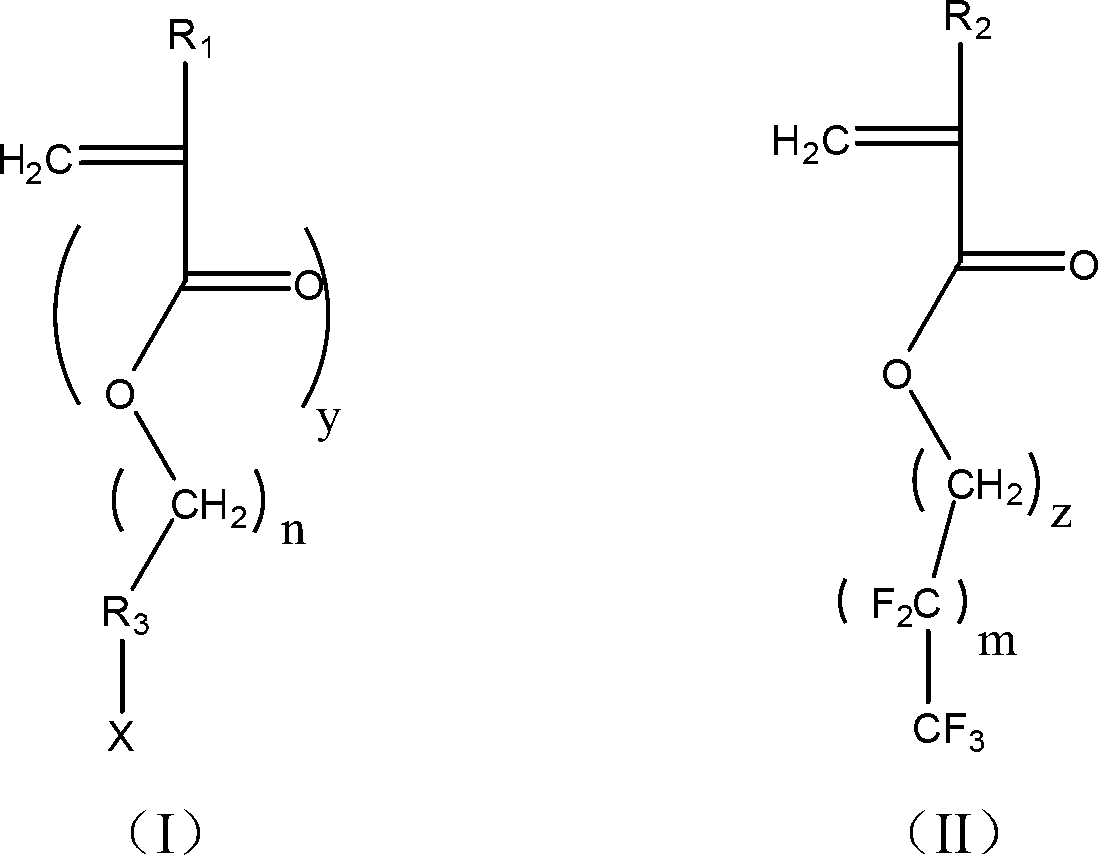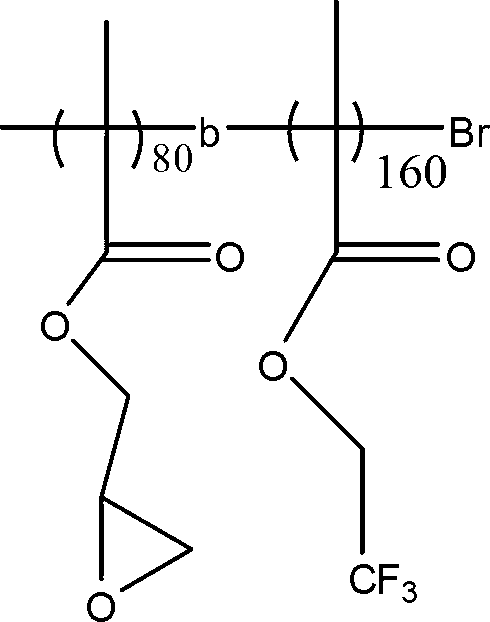Cross-linkable fluorine-containing polymer, and its application in preparation of super-amphiphobic surfaces
A super-amphiphobic surface and polymer technology, which can be used in manufacturing tools, plant fibers, coatings, etc. problem, to achieve the effect of simple method and firm bonding
- Summary
- Abstract
- Description
- Claims
- Application Information
AI Technical Summary
Problems solved by technology
Method used
Image
Examples
Embodiment 1
[0055] Synthesis of crosslinkable fluoropolymers by ATRP method comprises the following steps:
[0056] Add 1.852g glycidyl methacrylate, 0.203g monomethoxyethylene glycol 2-bromoisobutyrate, 0.237g 4,4'-dinonyl-2,2'- Bipyridine and 3ml of anisole, the reaction system was stirred and dissolved, bubbled with argon for 30min, and then deoxygenated, then the reaction system was transferred to a 50ml round-bottomed flask containing 0.1124g of cuprous bromide, at 40°C The polymerization reaction was carried out for 2 hours, and the reaction product was precipitated in methanol, washed with methanol and then washed with n-hexane, and then vacuum-dried at room temperature for 24 hours to constant weight to obtain the product PGMA (polyglycidyl methacrylate).
[0057] In a 100ml round bottom flask, add 1.5g polyglycidyl methacrylate synthesized above, 1.852g trifluoroethyl methacrylate, 0.737g 4,4'-dinonyl-2,2'-bipyridine and 4ml of trifluorotoluene, stirring and dissolving the react...
Embodiment 2
[0061] Synthesis of crosslinkable fluoropolymers by anionic polymerization, comprising the following steps:
[0062] At -78°C (dry ice acetone bath), add 0.19 ml of 1,1-diphenylethylene to a three-necked flask containing 250 ml of anhydrous tetrahydrofuran, followed by adding 0.6 ml of 1.4 mol / L sec-butyllithium in hexyl alkane solution. After 25 minutes, 25.19 milliliters of propenyl glycidyl ether was added, and 1.24 milliliters of pentafluoroethyl methacrylate was added after the polymerization reaction was carried out for 1 hour. After the polymerization reaction continued for another 2 hours, 1.0 milliliters of anhydrous methanol was added to terminate the polymerization reaction. After the reaction system was warmed up to 23° C., it was concentrated by distillation to 100 ml, and then the polymer was precipitated in excess methanol, filtered and dried in a vacuum oven to obtain the polymer PGA-b-PFEMA. The molecular weight of the product is 31920.
[0063] The structur...
Embodiment 3
[0066] The synthesis of crosslinkable fluoropolymers by free radical method comprises the following steps:
[0067] Add 15g perfluorooctyl ethyl acrylate, 1.852g 1,2-epoxy-5-hexene, 0.174g AIBN as initiator and 50ml trifluorotoluene into a 100ml round bottom flask, stir and dissolve the reaction system , bubbling with argon gas for 30 minutes, carrying out the polymerization reaction at 90°C for 8h, the reaction product was precipitated in methanol, washed with methanol and then washed with n-hexane, and then vacuum-dried at 40°C for 24h to constant weight to obtain the product. The molecular weight of the product is 68880.
[0068] The structure of the product is shown below:
[0069]
PUM
 Login to View More
Login to View More Abstract
Description
Claims
Application Information
 Login to View More
Login to View More - R&D
- Intellectual Property
- Life Sciences
- Materials
- Tech Scout
- Unparalleled Data Quality
- Higher Quality Content
- 60% Fewer Hallucinations
Browse by: Latest US Patents, China's latest patents, Technical Efficacy Thesaurus, Application Domain, Technology Topic, Popular Technical Reports.
© 2025 PatSnap. All rights reserved.Legal|Privacy policy|Modern Slavery Act Transparency Statement|Sitemap|About US| Contact US: help@patsnap.com



